Nothing found!
It looks like nothing was found here. Maybe try a search?
Categories
- 1910s
- 1920s
- 1930s
- 1940s
- 1950s
- 1960s
- 1970s
- 1980s
- 1990s
- 2000s
- AMC
- Aston Martin
- Autobianchi
- Bentley
- BMW
- Bristol
- Buick
- Cadillac
- Chevy
- Chrysler
- Citroen
- Classic Cars
- Classic Hot Rods
- Classic Muscle Cars
- Classic Sports Cars
- Cunningham
- Davis
- Duesenberg
- Edsel
- Facel Vega
- Ferrari
- Fiat
- Ford
- Ghia
- Hillman
- Hudson
- Jaguar
- Kaiser
- Lamborghini
- Luxury Car
- Maserati
- Mercedes-Benz
- Moretti
- Packard
- Panhard
- Plymouth
- Porsche
- Reliant
- Rolls-Royce
- Studebaker
- Toyota
- Uncategorized
- Vespa
- Volvo
- Wolseley
The history of Willys is a story of American automotive innovation, particularly in the field of military vehicles, and the brand’s role in contributing to the Allied victory during World War II. Willys-Overland Motors, commonly known as Willys, was a significant American automaker with a legacy that includes the production of the iconic Willys MB, better known as the Jeep.
The company’s origins can be traced back to the early 20th century when John North Willys purchased the Overland Automotive Division of Standard Wheel Company in 1907. This marked the beginning of the Willys-Overland Motor Company, which initially focused on producing automobiles.
In the 1930s, Willys faced financial challenges during the Great Depression but managed to survive by producing affordable and compact cars, including the Willys 77 and the Willys Americar.
Willys gained widespread recognition and acclaim during World War II when it became a major supplier of military vehicles to the United States and its allies. The company’s most famous contribution was the Willys MB, a rugged and versatile four-wheel-drive vehicle that would later become known as the Jeep.
The Jeep was designed for military use, featuring a compact design, exceptional off-road capabilities, and a powerful engine. It was used for a wide range of purposes, including reconnaissance, transportation, and as an ambulance. The Jeep’s reliability and adaptability made it a crucial asset on the battlefield.
The Jeep’s popularity continued after the war, with surplus military vehicles finding their way into civilian hands. The Willys CJ (Civilian Jeep) was introduced in the post-war period, becoming the precursor to the modern sport utility vehicle (SUV).
In 1953, Willys-Overland was purchased by Kaiser-Frazer Corporation and became Willys Motors, Inc. The company continued to produce Jeeps, including models like the Jeep Wagoneer and the Jeep Gladiator.
The Jeep brand and its association with rugged off-road vehicles grew in the following decades, leading to the establishment of the Jeep division within American Motors Corporation (AMC) when AMC acquired Jeep from Kaiser Industries in 1970.
Eventually, the Jeep brand was sold to Chrysler Corporation in 1987, and it became an integral part of the Chrysler family of brands. Today, Jeep is known for producing a wide range of SUVs and off-road vehicles that continue to capture the spirit of adventure and exploration.
Willys’ legacy is enduring, primarily through the iconic Jeep brand. The Jeep logo, featuring the seven-slot grille, remains one of the most recognized symbols in the automotive world, symbolizing the brand’s heritage of ruggedness, versatility, and American innovation.




